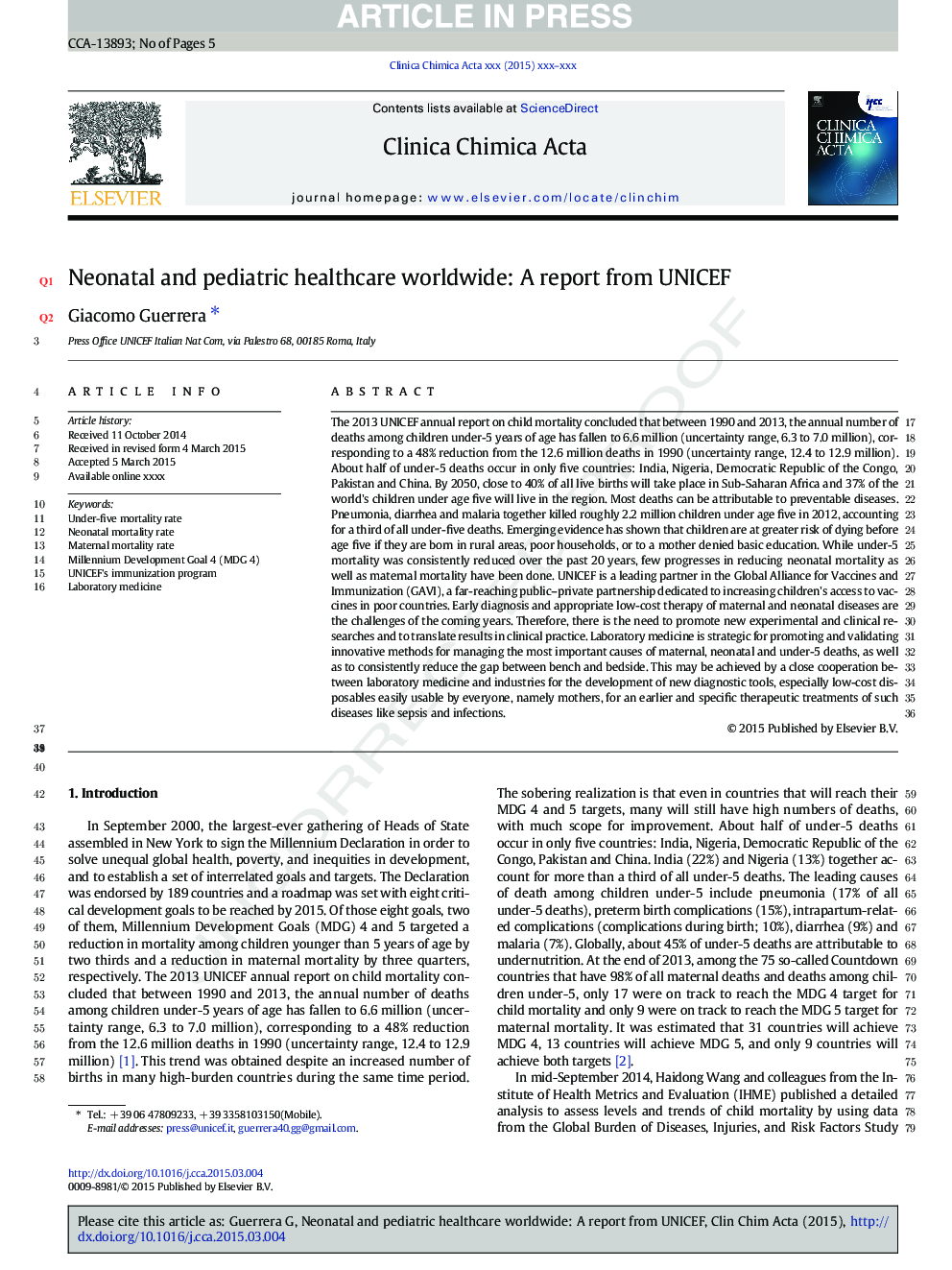| کد مقاله | کد نشریه | سال انتشار | مقاله انگلیسی | نسخه تمام متن |
|---|---|---|---|---|
| 10817272 | 1058750 | 2015 | 5 صفحه PDF | دانلود رایگان |
عنوان انگلیسی مقاله ISI
Neonatal and pediatric healthcare worldwide: A report from UNICEF
ترجمه فارسی عنوان
مراقبت های بهداشتی نوزادان و کودکان در سراسر جهان: یک گزارش از یونیسف
دانلود مقاله + سفارش ترجمه
دانلود مقاله ISI انگلیسی
رایگان برای ایرانیان
کلمات کلیدی
میزان مرگ و میر کودکان زیر 5 سال، مرگ و میر نوزادان، میزان مرگ و میر مادران، اهداف توسعه هزاره 4 (اهداف توسعه 4)، برنامه ایمن سازی یونیسف، طب آزمایشگاهی،
موضوعات مرتبط
علوم زیستی و بیوفناوری
بیوشیمی، ژنتیک و زیست شناسی مولکولی
زیست شیمی
چکیده انگلیسی
The 2013 UNICEF annual report on child mortality concluded that between 1990 and 2013, the annual number of deaths among children under-5Â years of age has fallen to 6.6 million (uncertainty range, 6.3 to 7.0 million), corresponding to a 48% reduction from the 12.6 million deaths in 1990 (uncertainty range, 12.4 to 12.9 million). About half of under-5 deaths occur in only five countries: India, Nigeria, Democratic Republic of the Congo, Pakistan and China. By 2050, close to 40% of all live births will take place in Sub-Saharan Africa and 37% of the world's children under age five will live in the region. Most deaths can be attributable to preventable diseases. Pneumonia, diarrhea and malaria together killed roughly 2.2 million children under age five in 2012, accounting for a third of all under-five deaths. Emerging evidence has shown that children are at greater risk of dying before age five if they are born in rural areas, poor households, or to a mother denied basic education. While under-5 mortality was consistently reduced over the past 20Â years, few progresses in reducing neonatal mortality as well as maternal mortality have been done. UNICEF is a leading partner in the Global Alliance for Vaccines and Immunization (GAVI), a far-reaching public-private partnership dedicated to increasing children's access to vaccines in poor countries. Early diagnosis and appropriate low-cost therapy of maternal and neonatal diseases are the challenges of the coming years. Therefore, there is the need to promote new experimental and clinical researches and to translate results in clinical practice. Laboratory medicine is strategic for promoting and validating innovative methods for managing the most important causes of maternal, neonatal and under-5 deaths, as well as to consistently reduce the gap between bench and bedside. This may be achieved by a close cooperation between laboratory medicine and industries for the development of new diagnostic tools, especially low-cost disposables easily usable by everyone, namely mothers, for an earlier and specific therapeutic treatments of such diseases like sepsis and infections.
ناشر
Database: Elsevier - ScienceDirect (ساینس دایرکت)
Journal: Clinica Chimica Acta - Volume 451, Part A, 7 December 2015, Pages 4-8
Journal: Clinica Chimica Acta - Volume 451, Part A, 7 December 2015, Pages 4-8
نویسندگان
Giacomo Guerrera,
